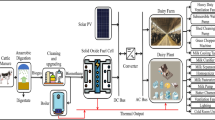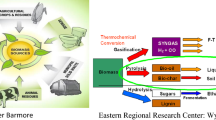Abstract
Solar cooking is one of the cost-effective ways to reduce deforestation. The major goal of current study is to examine the thermal performance of a solar cooker using low-cost heat storage material. The cooker has an angled surface called a reflector to collect the maximum solar energy. Various low-cost heat materials, such as water, ethylene glycol, desert sand, charcoal, and copper grits, and their mixtures were prepared and tested for optimal performance as thermal heat storage material inside insulated and uninsulated solar-cooker. The experiments were performed under climatic conditions of Karachi, Pakistan. Results showed that the cooker provided suitable temperatures for healthy food preparation. Insulation improves the performance of the cooker. The use of copper grits as a heat storing material allows for a maximum temperature of 110 °C within the insulated cooker. After solar noon, the temperature measurements reached their highest and stabilized. Additionally, it was found that the performance of the copper, sand, and charcoal mixture was diminished when ethylene glycol was added. The performance of the copper, sand, and charcoal mixture was reduced when ethylene glycol was added. The performance of the mixture of sand, charcoal, and copper grits was found to be insignificant.
Zusammenfassung
Solarkochen ist eine der kostengünstigen Möglichkeiten, die Entwaldung zu reduzieren. Das Hauptziel der aktuellen Studie besteht darin, die thermische Leistung eines Solarkochers mit kostengünstigem Wärmespeichermaterial zu untersuchen. Der Herd verfügt über eine abgewinkelte Oberfläche, die als Reflektor bezeichnet wird, um die maximale Sonnenenergie zu sammeln. Verschiedene kostengünstige Wärmematerialien wie Wasser, Ethylenglykol, Wüstensand, Holzkohle und Kupfergrieß sowie deren Mischungen wurden vorbereitet und auf optimale Leistung als Wärmespeichermaterial in isolierten und nicht isolierten Solarkochern getestet. Die Experimente wurden unter den klimatischen Bedingungen von Karachi, Pakistan, durchgeführt. Die Ergebnisse zeigten, dass der Herd geeignete Temperaturen für eine gesunde Lebensmittelzubereitung lieferte. Die Isolierung verbessert die Leistung des Herdes. Die Verwendung von Kupferspänen als Wärmespeichermaterial ermöglicht eine maximale Temperatur von 110 °C im isolierten Kocher. Nach dem Sonnenmittag erreichten die Temperaturmessungen ihren Höchststand und stabilisierten sich. Darüber hinaus wurde festgestellt, dass die Leistung der Kupfer-, Sand- und Holzkohlemischung durch die Zugabe von Ethylenglykol beeinträchtigt wurde. Die Leistung der Kupfer-, Sand- und Holzkohlemischung wurde durch die Zugabe von Ethylenglykol verringert. Die Leistung der Mischung aus Sand, Holzkohle und Kupfergrieß erwies sich als unbedeutend.













Similar content being viewed by others
References
Uzair M (2018) Wind induced heat losses from solar dish-receiver systems. Dissertation, Auckland University of Technology
Saxena A, Pandey SP, Srivastav G (2011) A thermodynamic review on solar box type cookers. Renew Sustain Energy Rev 15(6):3301–3318
Hager TJ, Morawicki R (2013) Energy consumption during cooking in the residential sector of developed nations: A review. Food Policy 40:54–63
Shazad A, Uzair M (2023) Utilization of Solar Energy for Cooling Applications. Memoria Investigaciones en Ingeniería 24:69–91. https://doi.org/10.36561/ING.24.6
Modibo S, Siaka T, Soro D, Idrissa D, Marí B (2019) Experimental Study of a Parabolic Solar Concentrator with Optimized Back Axial Distance of the Focal Point. Int J Mater Eng Technol 18:17–40
Sethi VP, Pal DS, Sumathy K (2014) Performance evaluation and solar radiation capture of optimally inclined box type solar cooker with parallelepiped cooking vessel design. Energy Convers Manag 81:231–241
Abu-Malouh R, Abdallah S, Muslih IM (2011) Design, construction and operation of spherical solar cooker with automatic sun tracking system. Energy Convers Manag 52(1):615–620
Achamyeleh T, Ramu S, Bantelay S, Srinivasan R (2017) Experimental comparison of solar cooker using black coated and aluminum coated box IIJME5:7–12
Mohammed IL, Rumah UJ, Abdulrahim AT (2013) Performance testing of a truncated pyramid solar thermal cooker. Int J Eng Res Appl (ijera) 3(4):1174–1178
Tekle A (2014) Experimental assessment on thermal performance and efficiency of pyra-box solar cooker. J Energy Technol Policy 4(7):58–65
Vengadesan E, Senthil R (2021) Experimental investigation of the thermal performance of a box type solar cooker using a finned cooking vessel. Renew Energy 171:431–446
Musa, H., Maina, M. B., & Abdulrahim, A. T. (2020). Experimental Studies of Solar Box Cooker Using Energy and Exergy Efficiency Analysis in a Semi-Arid Environment. ATBU Journal of Science, Technology and Education, 8(3), 307–318.
Amosun ST, Samuel OD, Idi S, Ashiedu FI, Fayomi OSI, Anisiji EO, Nelson JO (2021) Development and performance evaluation of a. Box-type Sol Cooker iop Conf Series: Mater Sci Eng 1107(1):12222 (IOP Publishing)
Soro D, Soro D, Sidibé M, Doumbia Y, Touré S, Marí B (2020) Theoretical and Experimental Studies of a Box-Type Solar Cooker in Unfavorable Climatic Conditions. Smart Grid Renew Energy 11(4):51–60
Sitepu, T., Gunawan, S., Nasution, D. M., Ambarita, H., Siregar, R. E. T., & Ronowikarto, A. D. (2017). Experimental Study on Performance of a Box Solar Cooker with Flat Plate Collector to Boil Water. In IOP Conference Series: Materials Science and Engineering (Vol. 180, No. 1, p. 012032). IOP Publishing.
Mu’azu Musa MI (2020) The Effects of Additional Solar Reflection on Increasing the Temperature in the Cooking Chamber of a Box Solar Cooker. Int J Multidiscip Res Publ 3(4):4–8
Coccia G, Aquilanti A, Tomassetti S, Ishibashi A, Di Nicola G (2021) Design, manufacture and test of a low-cost solar cooker with high-performance light-concentrating lens. Sol Energy 224:1028–1039
Kakar MA, Kasi JK, Kasi AK, Bokhari M, Latif M, Ayaz M (2019) The Efficiency of a Solar Cooker in Pakistan’s Quetta Region. Pol J Environ Stud 28(6):4213–4220
Srivastava, S. K., Shukla, A., Tiwari, R., & Rai, A. K. (2020). Studies on solar box cooker with thermal energy storage. International Journal of Advanced Research in Engineering and Technology (IJARET) 11(10):410–417
Palanikumar G, Shanmugan S, Chithambaram V, Gorjian S, Pruncu CI, Essa FA, Kabeel AE, Panchal H, Janarthanan B, Ebadi H, Elsheikh AH (2021) Thermal investigation of a solar box-type cooker with nanocomposite phase change materials using flexible thermography. Renew Energy 178:260–282
Milikias E, Bekele A, Venkatachalam C (2021) Performance investigation of improved box-type solar cooker with sensible thermal energy storage. Int J Sustain Eng 14(3):507–516
Nahar NM (2003) Performance and testing of a hot box storage solar cooker. Energy Convers Manag 44(8):1323–1331
Shrestha JN, Byanjankar MR (2007) Thermal performance evaluation of box type solar cooker using stone pebbles for thermal energy storage. J Renew Energy Smart Grid Technol 2(2):24–44
Saxena, A., & Karakilcik, M. (2017). Performance evaluation of a solar cooker with low cost heat storage material. Int. J. Sustain. Green Energy 6(4):57–63.
Cuce PM (2018) Box type solar cookers with sensible thermal energy storage medium: A comparative experimental investigation and thermodynamic analysis. Sol Energy 166:432–440
Saxena A, Agarwal N (2018) Performance characteristics of a new hybrid solar cooker with air duct. Sol Energy 159:628–637
Saxena A, Cuce E, Tiwari GN, Kumar A (2020) Design and thermal performance investigation of a box cooker with flexible solar collector tubes: An experimental research. Energy 206:118144
Saxena A, Norton B, Goel V, Singh DB (2022) Solar cooking innovations, their appropriateness, and viability. Environ Sci Pollut Res 29(39):58537–58560
Coccia G, Di Nicola G, Tomassetti S, Pierantozzi M, Chieruzzi M, Torre L (2018) Experimental validation of a high-temperature solar box cooker with a solar-salt-based thermal storage unit. Sol Energy 170:1016–1025
Hosseinzadeh M, Sadeghirad R, Zamani H, Kianifar A, Mirzababaee SM (2021) The performance improvement of an indirect solar cooker using multi-walled carbon nanotube-oil nanofluid: An experimental study with thermodynamic analysis. Renew Energy 165:14–24
Kumar A, Saxena A, Pandey SD, Gupta A (2023) Cooking performance assessment of a phase change material integrated hot box cooker. Environ Sci Pollut Res. https://doi.org/10.1007/s11356-023-25340-x
Shaikh M, Uzair M, Allauddin U (2021) Effect of geometric configurations on charging time of latent-heat storage for solar applications. Renew Energy 179:262–271
Shaikh M, Uzair M, Raza AS (2022) Optimization of thermal storage using different materials for cooking with solar power. Trans Can Soc Mech Eng 46(2):490–502
Saxena A, Joshi SK, Gupta P, Tirth V, Suryavanshi A, Singh DB, Sethi M (2023) An experimental comparative analysis of the appropriateness of different sensible heat storage materials for solar cooking. J Energy Storage 61:106761
Uzair M, Rehman NU (2021) Intercept factor for a beam-down parabolic trough collector. J Sol Energy Eng 143(6):61002
Uzair, M., ur Rehman, N., & Raza, S. A. (2018). Probabilistic approach for estimating heat fluid exit temperature correlation in a linear parabolic trough solar collector. Journal of Mechanical Science and Technology 32:447–453
Rizvi SAA, Uzair M (2023) Numerical Investigation of Solar Flux Homogeneity and Intensity of a. Eng,. Parabolic, Trough Receiver with Various Secondary Reflectors. Arab J Sci 48:4081–4094 https://doi.org/10.1007/s13369-022-07372-6
Rehman NU, Uzair M, Asif M (2021) Optical Design of a Novel Polygonal Trough Collector for Solar Concentrating Photovoltaic Applications. Arab J Sci Eng 46:2963–2973
A. Farzanehnia, M. Khatibi, M. Sardarabadi, and M. Passandideh-Fard, “Experimental investigation of multiwall carbon nanotube/paraffin based heat sink for electronic device thermal management,” Energy Convers. Manag., vol. 179, pp. 314–325, 2019, https://doi.org/10.1016/j.enconman.2018.10.037.
S. Srivastava and A. Yadav, “Water generation from atmospheric air by using composite desiccant material through fixed focus concentrating solar thermal power,” Sol. Energy, vol. 169, pp. 302–315, 2018, https://doi.org/10.1016/j.solener.2018.03.089.
A. Malan, V. Kamboj, A. K. Sharma, and A. Yadav, “The regeneration of various saturated solid and novel composite desiccant using Scheffler solar concentrator: an experimental investigation,” Int. J. Ambient Energy, vol. 41, no. 2, pp. 224–236, Jan. 2020, https://doi.org/10.1080/01430750.2018.1456965.
Author information
Authors and Affiliations
Corresponding author
Ethics declarations
Conflict of interest
S.A. Ali Rizvi, M. Uzair and M.A. Siddiqui declare that they have no competing interests.
Rights and permissions
Springer Nature or its licensor (e.g. a society or other partner) holds exclusive rights to this article under a publishing agreement with the author(s) or other rightsholder(s); author self-archiving of the accepted manuscript version of this article is solely governed by the terms of such publishing agreement and applicable law.
About this article
Cite this article
Ali Rizvi, S.A., Uzair, M. & Siddiqui, M.A. The effects of using different thermal storage materials and their mixtures on the performance of a solar cooker. Forsch Ingenieurwes 87, 1285–1295 (2023). https://doi.org/10.1007/s10010-023-00714-2
Received:
Accepted:
Published:
Issue Date:
DOI: https://doi.org/10.1007/s10010-023-00714-2




